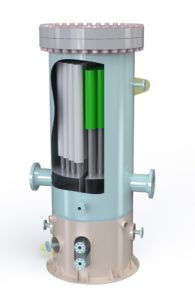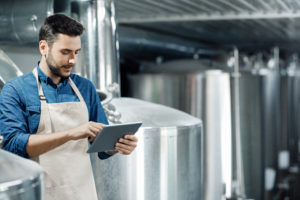Multi Billion Dollar Market to Separate Liquids from Oil and Gas
The market to remove liquids from oil and gas is close to $2 billion per year and includes the range of devices to remove both small and large droplets as well as water in emulsified solutions. This is the conclusion reached by the McIlvaine Company in Liquid Separation from Oil and Gas.
Water and other liquids need to be removed from natural and synthetic gas. Common applications are:
- Gas processing plants
- Pipeline compressor stations
- Storage
- LNG liquefaction /Regas plants
Natural gas processing consists of separating hydrocarbons and fluids from the pure natural gas to produce pipeline quality dry natural gas to be fed to gas transportation systems. High efficiency cartridge L/G coalescers are used for vapor removal from the gas stream during processing and transportation. Typically, they are used downstream from other separation equipment.
Gravity Separator - also known as knock-out drum, droplet removal >300 ?m; for bulk separation or first stage scrubber. The force used to separate solids and liquids from gas is gravity.
Centrifugal Separator- also known as cyclone separator, when properly sized can remove droplets down to 8-10?m.
Mist Eliminators - there are three types of mist eliminators:
Vane, also known as baffle, chevron or plate type, closely spaced blades arranged to provide zigzag gas flow paths, using inertial impaction for droplet removal >10?m; sturdier than mesh pads and impose less pressure drop, sometimes used in combination with mesh pads.
Mesh pad-most typical structure is knitted mesh pad in tightly packed layers; media composites of plastics or glass coalesce droplets > 1.0 ?m, media of metal or plastic wire for droplets > 5.0 ?m; large vessel required since operated at low velocity.
Fiber mist eliminators are in cylindrical form (candles) or flat panels and capable of separating particles > 0.5 ?m.
Coalescer cartridges are capable of high efficiency on particles > 0.1 ?m. The u usual configuration is vertical, where gas travels upward and flows from inside to outside of cartridge, where submicron droplets coalesce into larger droplets, then drain down. Liquid/Gas (L/G) cartridge coalescers can operate at peak performance at reduced flow rates (i.e., during partial shutdowns).
Different stages of separation are required. A knock-out drum will remove the larger droplets, followed downstream by a mist eliminator and/or a high efficiency cartridge coalescer. The different stages can be in separate vessels or in one vessel.
A high-efficiency vertical liquid/gas coalescer such as Pall s product is designed for inlet gas with liquid aerosol contamination entering at the bottom of the housing into a first-stage knock-out section. Here any slugs or large droplets are removed by gravitational settling. The gas then travels upward through a tube sheet and flows radially from the inside of the cartridges through the coalescer medium to the annulus. The inlet aerosol distribution ranges from 0.1 to 300 ?m, and after passing through the coalescer medium, is transformed into enlarged coalesced droplets ranging from 0.5 to 2.2 ?m.
Liquid-liquid coalescers can be segmented into stationary and mobile. In the stationary segment, the major players, accounting for approximately 30 percent of the revenues, are Pall, PECOFacet, ParkerVelcon, Jonell, Pentair, Faudi Aviation, Kaydon, Vokes and Sulzer.
Major companies supplying coalescing filters in the mobile sector include Mann+Hummel, Mahle, Donaldson and Racor.
Two of the largest media companies are Lydall and Hollingsworth and Vose (H&V).
Lydall Filtration/Separation, Inc. offers their LyPore UnityT liquid/liquid and liquid/gas coalescing media grades for efficient separation of both water from other liquids and oil and water from air streams. All grades are constructed with borosilicate microfiber glass that offers the highest level of coalescence at the lowest pressure drop. Lydall s fluoropolymer oil and water repellency treatment processes ensure exacting separation of target compounds and long element life. LyPore UnityT grades can be pleated or wrapped and are available in a wide range of efficiencies, repellency levels, and binders.
Hollingsworth & Vose (H&V) manufactures a comprehensive line of coalescer media solutions for applications that require gas-liquid and liquid-liquid separation. H&V offers a choice of fiberglass, cellulose and synthetic media combined with specialized organic binders. H&V microfiber glass media fibers are naturally oleophobic, so oil droplets adhere but do not swell them. The cellulose coalescer media is an economical alternative to glass. For applications requiring additional structural integrity, these media are also available with lamination.
Source: The McIlvaine Company




